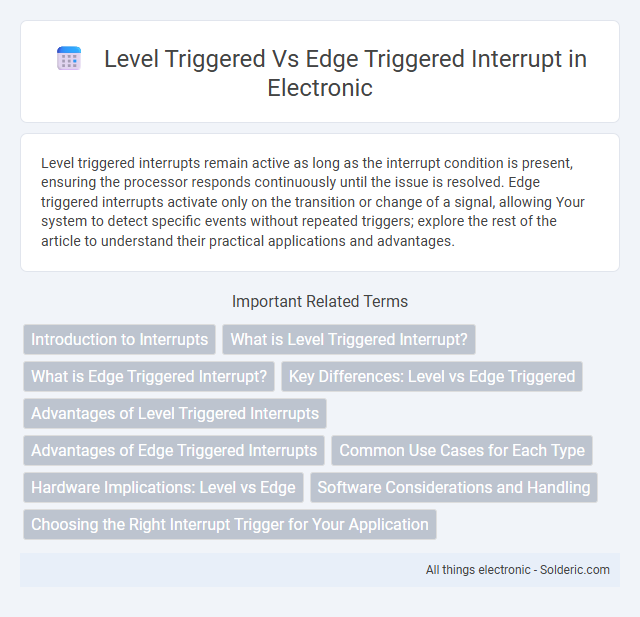Level triggered interrupts remain active as long as the interrupt condition is present, ensuring the processor responds continuously until the issue is resolved. Edge triggered interrupts activate only on the transition or change of a signal, allowing Your system to detect specific events without repeated triggers; explore the rest of the article to understand their practical applications and advantages.
Comparison Table
| Feature | Level Triggered Interrupt | Edge Triggered Interrupt |
|---|---|---|
| Trigger Type | Activated by a sustained signal level (high or low) | Activated by a transition or change in signal level (rising or falling edge) |
| Interrupt Signal | Continuous signal presence | Single pulse or transition |
| Interrupt Latency | Potentially longer due to signal level duration | Typically shorter as it's triggered at the moment of transition |
| Handling Complexity | Simpler hardware implementation | Requires edge detection circuitry |
| Interrupt Miss Risk | Lower risk due to persistent signal | Higher risk if edge is missed during processing |
| Use Cases | Suitable for devices with longer signal durations like keyboards | Ideal for high-speed peripherals requiring prompt attention |
| Example | Level-triggered GPIO interrupts | Edge-triggered timer interrupts |
Introduction to Interrupts
Interrupts are hardware or software signals that temporarily halt the CPU's current operations to prioritize urgent tasks. Level-triggered interrupts activate continuously while the interrupt signal remains at a specific voltage level, ensuring the processor acknowledges the signal until it is cleared. Edge-triggered interrupts respond only to voltage changes or transitions, such as from low to high, triggering a single interrupt event per signal transition.
What is Level Triggered Interrupt?
A level triggered interrupt is a type of hardware interrupt that remains active as long as the interrupt signal stays at a specific voltage level, usually high or low. This means the processor continuously acknowledges the interrupt while the signal level is maintained, ensuring no interrupt is missed during that period. Your system benefits from level triggered interrupts in scenarios where it is critical to respond to sustained conditions or faults.
What is Edge Triggered Interrupt?
Edge triggered interrupt activates when a signal transitions from low to high or high to low, detecting changes rather than sustained levels. This interrupt type is essential in systems requiring precise event detection without repeated triggering during signal persistence. It contrasts with level triggered interrupts, which respond as long as the signal maintains a specific logical state.
Key Differences: Level vs Edge Triggered
Level triggered interrupts activate when the interrupt signal remains at a specific voltage level, ensuring continuous CPU response until the signal clears. Edge triggered interrupts respond only to signal transitions, detecting changes from low to high or high to low voltage, providing precise, single-event CPU handling. Level triggered systems risk repeated servicing if the interrupt line stays active, while edge triggered systems prevent this by design, making them ideal for handling transient events.
Advantages of Level Triggered Interrupts
Level triggered interrupts offer reliable signal detection by maintaining an active interrupt level until the processor acknowledges it, ensuring no interrupts are missed. They allow for simpler hardware design with continuous monitoring, reducing complexity in interrupt handling circuits. This method is particularly advantageous in environments requiring guaranteed response to persistent conditions, such as I/O devices with slower data transfer rates.
Advantages of Edge Triggered Interrupts
Edge triggered interrupts offer advantages such as precise detection of signal changes by responding only to transitions rather than sustained levels, reducing the risk of missed events in systems with rapid state changes. They enable efficient handling of multiple interrupts without repeated servicing of the same event, improving system responsiveness and throughput. Edge triggered mechanisms are ideal for applications requiring immediate reaction to instantaneous events, minimizing latency compared to level triggered interrupts.
Common Use Cases for Each Type
Level-triggered interrupts are commonly used in scenarios requiring consistent signal monitoring such as keyboard inputs and hardware sensors, where the interrupt signal remains active as long as the condition persists. Edge-triggered interrupts are ideal for event-driven systems like networking devices and real-time clocks, responding to changes or transitions in signal states efficiently. In embedded systems, level-triggered interrupts simplify handling sustained conditions while edge-triggered interrupts optimize performance for rapid, transient events.
Hardware Implications: Level vs Edge
Level-triggered interrupts require the hardware to maintain the interrupt signal as long as the condition persists, necessitating continuous monitoring and potentially causing repeated servicing until the source is cleared. Edge-triggered interrupts detect changes or transitions, such as a rising or falling edge of a signal, enabling hardware to respond to discrete events efficiently without continuous sampling. Your system choice affects hardware complexity, with level-triggered designs demanding more robust signal holding circuits, while edge-triggered mechanisms rely on precise and responsive transition detection circuitry.
Software Considerations and Handling
Level-triggered interrupts require the software to continuously check the interrupt status until the condition is cleared, demanding careful management to avoid missed or repeated interrupts. Edge-triggered interrupts trigger an event only once per signal transition, so your handling routines must ensure interrupts are promptly acknowledged to prevent loss of events. Proper synchronization and debounce algorithms in your software are critical for reliable interrupt processing and system stability.
Choosing the Right Interrupt Trigger for Your Application
Level-triggered interrupts continuously signal the processor while the interrupt condition persists, making them suitable for hardware requiring guaranteed acknowledgment, such as peripheral devices with slower response times. Edge-triggered interrupts respond only to signal changes, offering faster and more efficient processing ideal for high-speed or transient events like keyboard input or network packets. Selecting the right trigger depends on factors like device response speed, required interrupt latency, and the complexity of handling repeated signals, where level-triggered simplifies repeated service and edge-triggered minimizes interrupt overhead.
level triggered vs edge triggered interrupt Infographic

 solderic.com
solderic.com